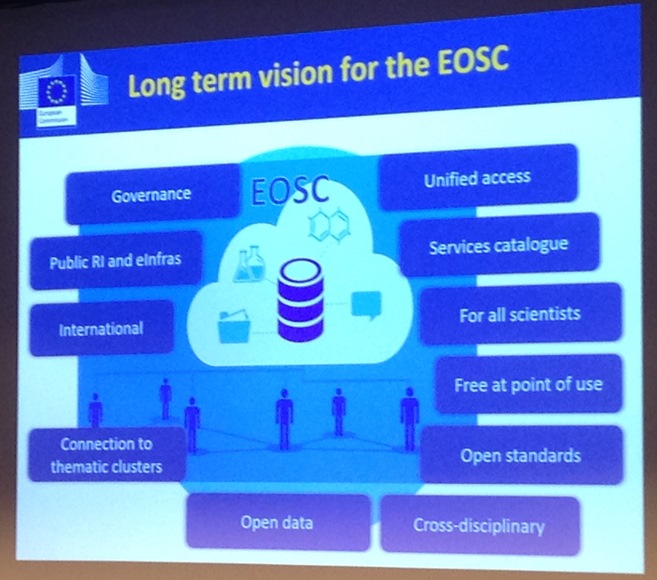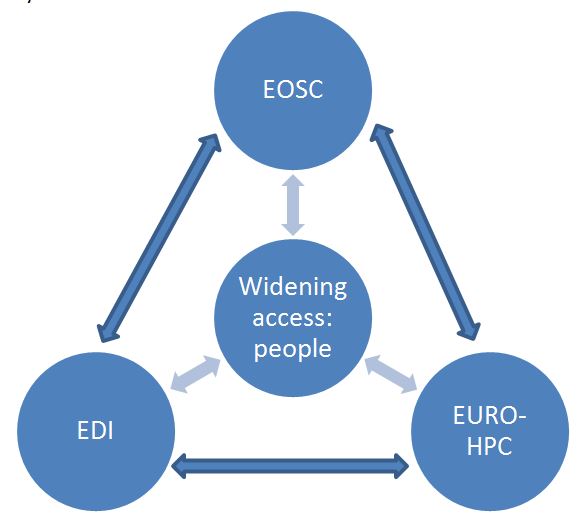During the last week of November two events related to the European Open Science Cloud (EOSC) took place in Brussels: the EOSC stakeholder forum on 28-29 November and the 2017 edition of the DI4R (Digital Infrastructures for Research). These two events were closely related in regard with the momentum period 2018-2020 for the Scientific Community and the advancement of open and digital science.
The vision
The European Open Science Cloud (EOSC) is currently a process to build a digital platform that is inspired by the F.A.I.R. principle. F.A.I.R. stands for: Findable, Accessible, Interoperable and Reusable.
FAIR is the idea between the recent actions taken by the European Commission and various funding agencies in favour of open data and open science. The EOSC platform, also called the EOSC-Hub, intends in fine to make possible to the whole European scientific Community and beyond: exchange of data, easy access to knowledge and access to all useful infrastructures for all scientific disciplines.
The word “Open” in EOSC must be understood in every possible way. It means (not exhaustively) that the platform will :
- promote open source software and open access culture
- make data as open as possible but as closed as necessary in regard with confidentiality and IPR (Intellectual Property Rights) concerns,
- be a mix of paid and free services and/or software
- be open to all users: research centres, public bodies, companies, citizens
- be accessible worldwide
- gather all infrastructures and technologies that are of help for scientists from all possible disciplines
Technically speaking, the general idea is to federate existing and yet to appear services, and to make these services interoperable with one another. Services and software can concern for example data and computation hosting, authentication, indexing, collaborative tools, data and service catalogues, etc. Thanks to the interoperability the researchers will be able to discover, navigate, use and re-use, data and combine them suing a various number of infrastructures. The interpretation of data is (or at last should be in our reading) quite broad here: it includes metadata and provenance, data models, tools and generally knowledge required to make sense of the data.
The core role of EOSC-Hub is to coordinate, foster interoperability, develop glue services, and generally speaking steer the efforts toward the needs of researchers. The outcome of the process is still unknown but the ambition is grand. Indeed, an EU official compared the EOSC to the internet. The WWW has been and still is a process, and it has changed the face of the Earth. The ambition of the EOSC is to change the way we do Science. An explanatory video is available here.
The EOSC will eventually be linked to the future pan-European HPC, as well as with the future European Data Infrastructure (EDI) which are funded alongsie the EOSC by the European Commission. The EDI and the EOSC may at the end of the day merge, since differences of purpose for each is not yet fully clear.
Political support and public funding
The EOSC is part of two strategies of the European Commission: the Digital Single Market on one hand and the European Research Area on the other hand.
The EOSC is the combination of the two, as it aims at creating a single research community without country or technical barriers (interoperability between software and services).
In its Work Programme 2018-2020 for European Research Infrastructures, the European Commission has put 375 million Euros on the table for “implementing the European Open Science Cloud”. It was initially planned to open a topic of 79M€ for adding other services and infrastructures to the EOSC, but it was postponed after 2020 for the 9th Framework Programme for research and Innovation. According to Augusto Burgueño Arjon, Head of the Unit “eInfrastructure & Science Cloud” at the DG Communication and Networks at the European Commission, it is not yet decided what this fund will be used for as it will depend on the evolution of the EOSC-Hub. AS according to the Commission and main supporters there is no room for failure, the next 3 years will be crucial. If EOSC implementation is a success, the first half of FP9 will focus on aggregating remaining infrastructures and services while the second half of FP9 will focus on sustaining and scaling the EOSC.
Member States are pushing forward the EOSC as well. Germany and the Netherlands issued in May 2017 a joint position paper on the EOSC, which France officially joined on the 01/12/2017. Furthermore 13 Member States have of to date signed an agreement to start a pan-European HPC programme. This new infrastructure will follow Prace and will be closely connected to EOSC.
Infrastructures involved
Outside of public institutions there are 6 major players pushing forward the EOSC:
- EGI (federation of cloud providers and data centres)
- EUDAT (data services),
- OpenAire (open publication services),
- Géant (network services)
- Indigo Data-Cloud (cloud services for science)
Together they built a consortium of 74 partners coordinated by EGI, in order to answer the call H2020-EINFRA-12-2017(a) within the Work Programme 2018-2020. This project named “EOSC-Hub project” will receive 30M€ by the Commission for the 2018-2020 period. Beneficiaries include Research Infrastructures, national e-Infrastructure providers, SMEs and academic institutions. This consortium will be focused on and addressing issues of the EOSC such as interoperability, adoption of open standards and protocols, governance structure etc
Indeed, our impression is that - while the vision is clear - the design and realisation of this vision has no clear shape yet: many ideas and components are floating around, some fully or half realised but simultaneously many questions remain unanswered or have not even been asked yet. This state of affairs is not surprising: the vision is grand and has the potential to disrupt (positively) the way in which research is carried out today; the actors are human beings, scientists, institutes, funding bodies and states all with their own priorities and constraints. Furthermore, there are real technical challenges in putting this “Cloud” together, and there are also cultural challenges to move more and more research activities towards Open Science. Existing metrics for academics and research institutions do not generally incentivise open science; which makes change of behaviour difficult. The biggest challenge for the EOSC is then maybe the challenge of skills and habit because as it was heard from an EU official: “if we do all this and no one is using it, it will be worthless”.
Some infrastructures and services were presented during the DI4R conference as “EOSC building blocks”. The presentations are all available following this link.
Two presentations attracted our attention:
- Hubzero presentation: open source platform for scientific and educational collaboration
- Presentation introducing to FAIR: nothing new but explains principles for EOSC
Contributions are open on Github to help develop FAIR metrics for EOSC.
OpenDreamKit and the EOSC
It seems that no e-infrastructure or service presented at the events specifically targets math-based research and teaching, so there could be some room for components of the OpendreamKit VRE.
Partnership with EGI
Indeed there is an existing collaboration between EGI and OpenDreamKit for the deployment of JupyterHub in EGI services. This collaboration will become official in the next weeks with the signature of a Memorandum of Understanding between the two parties. Depending on the success of this joint work and of the need of the EOSC post-2020, the collaboration could be extended.
Lobby
OpenDreamKit as a consortium promoting Open Source software and Open Data in the name of large communities can take lobbying actions to have an impact on the shape of the future EOSC. The following actions can and will be taken:
- Become a stakeholder of the EOSC:
1) Endorse the principles of the EOSC declaration by sending an official statement by mail
2) Commit to take some of the specific actions forward
Endorsement and commitment must be sent at RTD-EOSC@EC.EUROPA.EU.
- Contact experts implied in the EOSC:
-
From External Board of EOSC working for the Commission: several experts including Jean-François ABRAMATIC (INRIA) and the chairperson John Womersley (European Spallation Source)
-
From the External Advisory Board of the EOSC-pilot project (launched in preparation of EOSC-Hub project): the list is available on their website. One expert, Françoise GENOVA, is also member of the OpenDreamKit Advisory Board.
-
- The European Commission Project Officer for OpenDreamKit is also deeply implied in the talks for the EOSC implementation, and the Coordinator will be in close relation with her in the next months and years.
Reference: Hans fangohr’s blogpost on his group page


